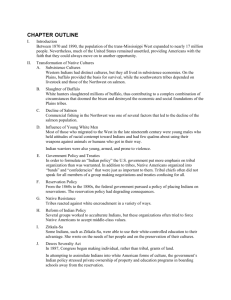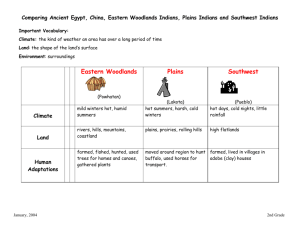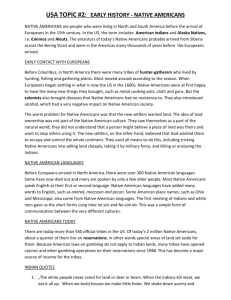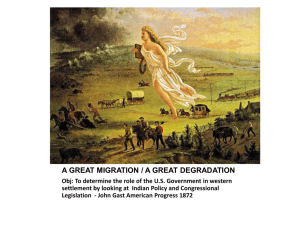Frontier West Review Questions
advertisement
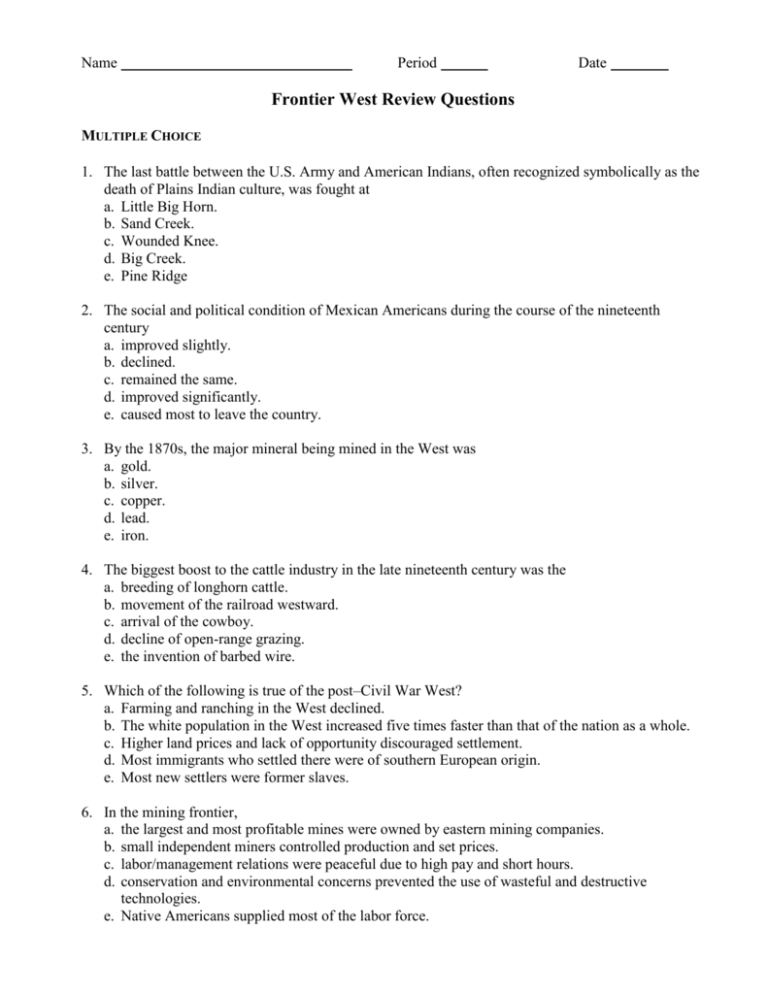
Name Period Date Frontier West Review Questions MULTIPLE CHOICE 1. The last battle between the U.S. Army and American Indians, often recognized symbolically as the death of Plains Indian culture, was fought at a. Little Big Horn. b. Sand Creek. c. Wounded Knee. d. Big Creek. e. Pine Ridge 2. The social and political condition of Mexican Americans during the course of the nineteenth century a. improved slightly. b. declined. c. remained the same. d. improved significantly. e. caused most to leave the country. 3. By the 1870s, the major mineral being mined in the West was a. gold. b. silver. c. copper. d. lead. e. iron. 4. The biggest boost to the cattle industry in the late nineteenth century was the a. breeding of longhorn cattle. b. movement of the railroad westward. c. arrival of the cowboy. d. decline of open-range grazing. e. the invention of barbed wire. 5. Which of the following is true of the post–Civil War West? a. Farming and ranching in the West declined. b. The white population in the West increased five times faster than that of the nation as a whole. c. Higher land prices and lack of opportunity discouraged settlement. d. Most immigrants who settled there were of southern European origin. e. Most new settlers were former slaves. 6. In the mining frontier, a. the largest and most profitable mines were owned by eastern mining companies. b. small independent miners controlled production and set prices. c. labor/management relations were peaceful due to high pay and short hours. d. conservation and environmental concerns prevented the use of wasteful and destructive technologies. e. Native Americans supplied most of the labor force. 7. Most cowboys in the Old West were a. gunfighters who led exciting and glamorous lives. b. tall burly men who rode oversized horses. c. laborers who worked hard for little pay. d. similar to the handsome romantic heroes depicted in western movies. e. blacks and Mexican Americans. 8. The five “civilized tribes” a. sided with the Confederacy during the Civil War. b. were nomadic hunters who followed the buffalo across the plains. c. were the first organized group to openly oppose slavery in the United States. d. received millions of additional acres of land from the federal government in the 1860s. e. moved to Mexico after the Civil War. 9. The “Ghost Dance” was a. a religious movement that promised the destruction of the white man and the return of Indian land. b. a Halloween celebration popular among Czech and German immigrants on the plains. c. the only Indian cultural activity permitted by the Interior Department on the reservations in the 1890s. d. introduced by Christian missionaries as a means of undermining pagan rituals. e. a funeral ritual practiced by the Pueblo Indians. 10. In the period 1860 to 1870, relations between Indians and whites were characterized by a. the development of mutual trust and understanding. b. the assimilation of Indians into white society. c. the complete destruction of Indian culture and traditions. d. constant warfare and disputes over land ownership. e. Indians uniting with blacks against whites. 11. By 1890, the Sioux and other reservation Indians a. were rapidly adapting to a capitalist, agrarian lifestyle. b. had achieved full U.S. citizenship and equal rights. c. were reduced to lives of poverty, depression, and alcoholism. d. were profiting from the discovery of oil on their ancestral lands. e. were working in large numbers for the mining industry. 12. The Dawes Severalty Act a. protected tribal ownership of land and separate nation status. b. offered each Indian head of family 160 acres of farmland or 320 acres of grazing land. c. resulted in the addition of millions of acres to tribal holdings. d. only affected the five “civilized tribes.” e. led to the revival of traditional cultures. 13. In the post–Civil War period, the Spanish speaking peoples of the Southwest and California a. preserved many of their distinctive traditions. b. were increasingly confined to city barrios. c. lost much of their political influence. d. were forced out of the gold fields. e. all of the above 14. In 1890, the Bureau of Census announced that a. 60 percent of the U.S. population lived west of the Mississippi River. b. a majority of Americans were foreign born. c. the frontier line, which had once separated the settled from the unsettled areas of the continent, no longer existed. d. the number of immigrants coming to the United States was at the lowest point in history. e. most Americans now lived in urban areas rather than on farms. 15. According to Frederick Jackson Turner, American character and culture were primarily influenced by a. the Spanish and the French traditions. b. the development of civilized cities and towns. c. the spread of the plantation system. d. the existence of the frontier and the westward movement. e. war. 16. The “Battle” of Wounded Knee a. was the worst defeat in the history of the U.S. Army. b. was a shoot out between sheep herders and cattlemen in Wyoming. c. revitalized Plains Indian culture. d. symbolized the death of the Plains Indians’ way of life. e. defeated the Pueblo Indians of New Mexico. 17. Post–Civil War relations between Anglos and Mexican Americans in Texas were characterized by a. cooperation and friendliness. b. intimidation and hostility. c. mass deportations to Mexico. d. mutual respect and admiration. e. constant warfare. 18. The U.S. Army encouraged the slaughter of millions of buffalo a. because the buffalo limited the grazing range for cattle. b. in order to feed hungry industrial workers in the North. c. to stop the spread of disease among cattle herds in the Plains. d. because the great herds interfered with the building of the transcontinental railroad. e. in order to weaken the Plains Indians by depriving them of their source of food, clothing, and shelter. 19. Which of the following best describes post–Civil War race relations in the West and South? a. Most ethnic minorities experienced discrimination. b. Mexican Americans and Indians were allowed to vote. c. Local and state governments were more sympathetic to the needs of minorities than was the federal government. d. Only African Americans were segregated and disfranchised. e. A new era of racial harmony dawned. 20. President Grant’s “Peace Policy” toward the Indians a. called for the extermination of the wild tribes. b. continued the tradition of dealing with Indian tribes as “separate nations.” c. encouraged Indians to accept civilization, Christianity, and citizenship. d. offered the peaceful relocation of willing Indians to remote areas in Canada and Alaska. e. vastly expanded Indian land holdings. 21. The Cheyenne at Sand Creek were led by a. Black Kettle b. Sitting Bull c. Chief Joseph d. Little Crow e. John Brown 22. The “Peace Policy” toward Native Americans was undertaken by President a. Rutherford B. Hayes. b. Grover Cleveland. c. Ulysses S. Grant. d. James A. Garfield. e. William McKinley. 23. Longhorn cattle were introduced in southern Texas by a. German farmers. b. the Spaniards. c. Anglo ranchers. d. the Indians. e. Canadians. 24. Open-range grazing declined in the West because a. the range had become overstocked. b. record cold killed thousands of free range cattle. c. scientific breeding proved more profitable. d. ranchers began fencing their land. e. all of the above. 25. The Battle of Little Bighorn in which George A. Custer and his men were killed occurred after a. whites had entered the sacred Black Hills seeking gold. b. the U.S. army had massacred the Ghost Dancers at Wounded Knee. c. Custer had insulted the Sioux chief. d. the Sioux had been confined to a reservation in Dakota territory. e. the army had carried out mass executions of Indian prisoners of war. 26. UNDER THE DAWES ACT a. millions of acres of reservation lands were opened to white settlement. b. most Indians readily adapted to the new agricultural economy. c. the reservation system emerged stronger than ever. d. Indians actually ended up controlling more land. e. Indian religious practices were revived. TRUE/FALSE _____ 1. _____ 2. Since most Plains Indian cultures traditionally included an economy based on individually owned farms, tribal members quickly adapted to reservation life. During the Civil War, many major American Indian tribes signed treaties of alliance with the Confederacy. _____ 3. During the 1890s, the American West was the scene of many “wars” between farmers and large ranchers. _____ 4. Destructive farming techniques used in the West after the Civil War led to the idea that the Great Plains was “the Great American Desert.” _____ 5. Increases in the amount of rainfall on the Plains in the 1870s and 1880s proved cultivation actually changed the weather. _____ 6. The Spanish brought the first cattle into Texas in the 1700s. _____ 7. The hard rock miner is the best known and most lasting symbol of the Old West. _____ 8. Cheyenne leaders Sitting Bull and Crazy Horse defeated U.S. cavalrymen at Little Big Horn in July 1876. _____ 9. Spanish-speaking peoples in the Southwest and California managed to preserve much of their distinctive culture. _____ 10. When the railroads adopted a common gauge for track, northern lines had to adapt to the prevailing gauge used in the South. _____ 11. The Morrill Act turned land over to states to finance colleges. _____ 12. The United States had one transcontinental railroad in operation between 1869 and 1893. _____ 13. Mining and ranching were more important for the growth of the West than agriculture. _____ 14. The Texas Rangers protected Mexican Americans from Anglo violence. _____ 15. The first of the great cattle drives began in the spring of 1866. _____ 16. In the aftermath of the Civil War, the process of concentrating Indian tribes on reservations slowed down. _____ 17. According to Frederick Jackson Turner, the frontier shaped a new kind of democratic egalitarian culture. _____ 18. In the Sand Creek massacre half of the Indians killed were women and children. _____ 19. Under President Grant the Board of Indian Commissioners was staffed by former Indian fighters hostile to the interests of the natives. FILL-INS 1. The notorious massacre of hundreds of Indian women and children by Colonel John Chivington (1864) in Colorado occurred at ____________________. 2. The best known and wildest cow town in Kansas was ____________________. 3. ____________________ was the Colorado militia leader who provoked the Sand Creek Massacre. 4. Prior to the late 19th century the high plains region was labeled on maps as the _______________. 5. Eastern Americans were introduced to the myths of the West as they were entertained by _______________ show. 6. Plains Indian culture was based on the _____________. 7. _______________ led the campaign to crush the Sioux in retaliation for the defeat of Custer and his men at Little Big Horn. 8. A Century of Dishonor by ________________ emphasized the violence, exploitation and broken treaties that characterized relationships between Indians and whites. 9. The historian who contended that the frontier had shaped American character and culture was _________________.



